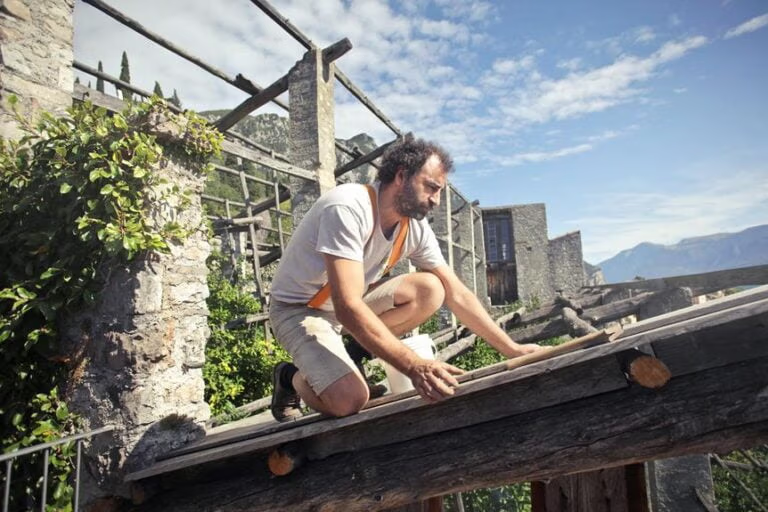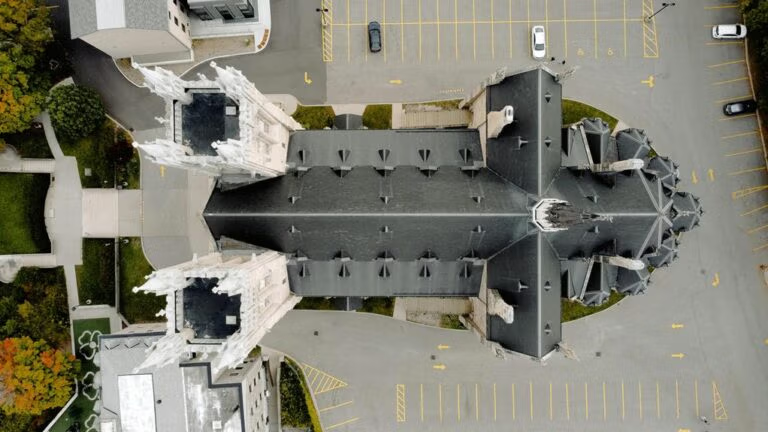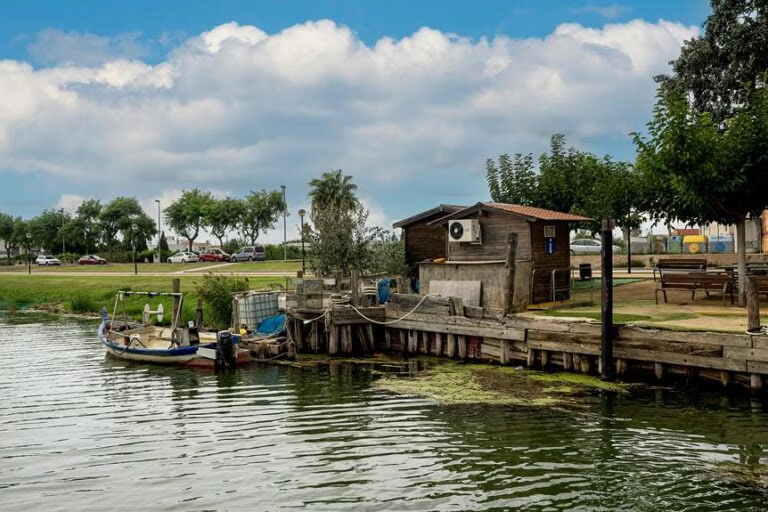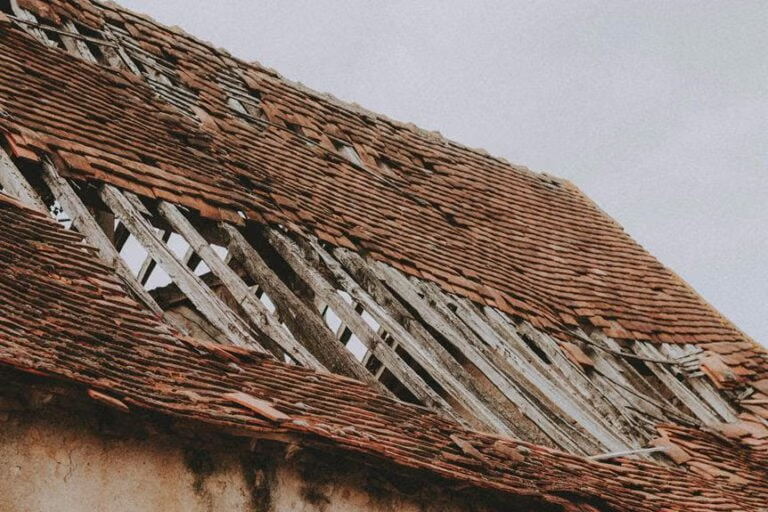Roofing felt, primarily composed of a base mat saturated with bitumen, serves as an essential barrier against water penetration. While it is designed to be moisture-resistant, roofing felt can sustain damage if exposed to water for an extended period. Moisture can degrade the material, leading to potential mold growth and reductions in durability. During installation, it's vital to limit exposure to wet conditions to preserve integrity. Protecting this layer effectively requires strategic waterproofing techniques and prompt repair of water-damaged sections. Exploring further can offer deeper insights into preventative measures and enhanced material options that optimize roof longevity.
Can Roofing Felt Get Wet
- Roofing felt can get wet, but prolonged exposure to moisture can degrade its integrity and effectiveness.
- Waterproofing agents in roofing felt help prevent water damage, but it's not immune to prolonged dampness.
- Proper installation, including correct overlapping and secure sealing of edges, is crucial to prevent water ingress.
- Moisture exposure risks include the potential for mold growth and structural compromise of the roofing system.
- Synthetic underlayment provides a more moisture-resistant alternative to traditional roofing felt, offering better protection against wet conditions.
Understanding Roofing Felt
Roofing felt, an essential barrier material composed of a base made from natural or synthetic fibers and coated with a waterproofing agent, plays a fundamental role in protecting buildings from water damage. This material is not just an extra layer; it's a primary defense against moisture ingress, ensuring that the structural integrity of the roof remains uncompromised.
The durability of roofing felt, often referred to as its 'felt lifespan,' is crucial. High-quality roofing felt can last for decades, provided it is installed correctly and maintained regularly. It acts as a resilient shield that repels water, thereby preventing leaks that could lead to costly repairs and structural issues. The lifespan of the felt plays a significant role in the overall longevity of the roofing system, making it a wise investment for those seeking long-term solutions.
Moisture protection is another essential aspect of roofing felt. It serves as an additional layer of defense, sitting beneath the primary roofing material. By blocking moisture, it prevents the wooden parts of the roof from rotting, thus maintaining the building's thermal efficiency and structural stability. This protection is particularly important in climates prone to heavy rain and snow, where water exposure is frequent and potentially damaging.
Roofing Felt Composition
Understanding the specific components that make up roofing felt is vital to appreciating its protective qualities and longevity. Roofing felt, often referred to as tar paper, is a pivotal layer in roofing structures, providing a barrier against moisture and enhancing the roof's overall durability. Its composition is designed to offer a blend of strength, flexibility, and moisture resistance, essential for maintaining the integrity of roofing systems.
The primary materials involved in the manufacturing of roofing felt include:
- Base Mat: Typically made from either natural fibers, such as wood cellulose, or synthetic ones like fiberglass or polyester. This base provides the structural foundation of the felt and contributes to its tear resistance and stability.
- Bitumen: This is the waterproofing component. Applied to the base mat, bitumen is either asphalt, coal tar, or a blend of both. Its role is crucial in enhancing the moisture resistance of the roofing felt, effectively repelling water and protecting the underlaying structures.
- Surfacing Materials: To increase durability and UV resistance, roofing felts are often coated with mineral granules or a fine sand. These materials not only protect the bitumen from the sun but also contribute to the overall aesthetic of the roofing system.
Each component of roofing felt is essential in ensuring that the material performs at its best, particularly regarding roofing felt properties like moisture resistance.
Effects of Moisture on Felt
Despite its inherent moisture-resistant properties, roofing felt can still be vulnerable to damage if exposed to water for prolonged periods. When felt absorbs excessive moisture, it can lead to felt degradation, manifesting in several detrimental ways. The fibers in the felt may swell and lose their structural integrity, making the material less effective as a barrier against further moisture ingress. Additionally, prolonged exposure to water can initiate the breakdown of the bituminous component of the felt, further compounding its vulnerability.
To mitigate these risks, various waterproofing methods are employed during the installation of roofing felt. One common approach is the use of sealants which enhance the felt's ability to repel water, thereby extending its lifespan and maintaining its structural properties. Another technique involves overlapping the sheets of felt correctly, which minimizes the chances of water seeping between layers and reaching the underlying structures.
Properly implemented, these methods not only preserve the effectiveness of the roofing felt as an essential underlayment in roofing systems but also secure that the freedom from water damage and related repairs is maximized, keeping the integrity of the roof intact over time. These strategic practices are pivotal in maintaining the felt's role as a reliable component in weatherproof roofing systems.
Installation Tips in Wet Conditions
When installing roofing felt in wet conditions, it is important to prepare for moisture exposure to guarantee the material's integrity and effectiveness. Employing efficient waterproofing techniques can greatly reduce the risk of water damage and extend the lifespan of the roofing system. These measures not only uphold the structural reliability of the roof but also prevent possible leaks that could result in expensive repairs.
Preparing for Moisture Exposure
To guarantee effective roof protection, it is important to adopt specific installation techniques when laying roofing felt under wet conditions. Moisture prevention begins with selecting the right materials and employing proper installation techniques to ensure the integrity of your roofing system. Utilizing moisture-resistant materials is not just a recommendation; it's a necessity in maintaining the effectiveness and longevity of roofing felt.
Here are essential tips for preparing for moisture exposure during installation:
- Choose High-Quality, Moisture-Repellent Felt: Opt for roofing felt that has been specifically treated to resist water absorption. This will serve as a critical barrier against moisture penetration, safeguarding the roof structure.
- Maintain Overlap Integrity: When installing the felt, make sure to overlap the sheets sufficiently. Recommended overlap measurements should be strictly followed to create a continuous barrier that prevents water ingress between the layers.
- Secure Sealing at Edges: Pay close attention to the edges and seams. Use appropriate waterproofing methods to seal these critical areas effectively. This step is crucial in preventing water from seeping under the felt, which can lead to significant damage over time.
Effective Waterproofing Techniques
How can you secure that roofing felt remains effectively waterproof even during wet installation conditions? Maintaining the integrity of roofing felt in damp environments begins with selecting high-quality, moisture-resistant materials. Opt for synthetic roofing felts as they generally offer superior waterproofing capabilities compared to organic options. Before installation, make sure that the surface is as dry as possible. Using a moisture meter can provide a quantitative measure of surface dampness, allowing for more informed decisions on whether to proceed with installation.
Implementing robust waterproofing options is critical. Apply a waterproof membrane underneath the roofing felt to act as an additional barrier against moisture. This technique not only enhances moisture prevention but also contributes to overall structural durability and quality assurance.
During installation, overlap the felt sheets adequately—typically by at least 4 inches—to create a continuous barrier against water ingress. Secure the overlaps with waterproof adhesives or specially designed lap sealants that enhance bonding in wet conditions.
Maintenance tips include regular inspections for any signs of damage or wear. Addressing these issues promptly prevents water from compromising the roofing structure. Always make sure that any repairs or replacements adhere to the same high standards of moisture prevention and quality assurance to maintain the effectiveness of the waterproofing system.
Long-Term Moisture Exposure
Long-term moisture exposure poses significant risks to roofing felt, impacting its overall effectiveness and lifespan. Continuous dampness can lead to the degradation of the material, increasing the likelihood of mold growth and decay, which jeopardizes the structural integrity of the roof. It is important for professionals to assess and mitigate these risks to maintain the roof's functionality and safety.
Durability Reduction Risks
Exposure to prolonged dampness greatly compromises the structural integrity of roofing felt, leading to accelerated deterioration. When roofing felt remains wet for extended periods, it becomes more susceptible to a variety of structural issues that can markedly reduce its effectiveness as a protective layer. This impact is not merely superficial but affects the felt's core functions.
The risks associated with long-term moisture exposure on roofing felt include:
- Reduced Moisture Protection: Initially intended to repel water and safeguard the roof structure, saturated roofing felt loses its hydrophobic qualities, allowing moisture to seep through and reach the underlying materials.
- Accelerated Material Degeneration: Constant exposure to dampness speeds up the breakdown of the felt's fibrous components. This degradation diminishes the felt's strength and flexibility, leading to tears and cracks which compromise the roof's integrity.
- Shortened Lifespan: The cumulative effect of moisture intrusion and material degradation notably shortens the roofing felt's lifespan. Effective maintenance practices become essential in extending the life and preserving the performance of the roofing felt.
To mitigate these risks, it is essential to employ rigorous moisture protection and consistent maintenance practices. Regular inspections and timely repairs play a pivotal role in preventing long-term damage and ensuring the roofing felt performs its role effectively.
Mold and Decay Potential
With prolonged exposure to moisture, roofing felt is highly prone to mold growth and structural decay. This vulnerability underscores the crucial need for robust mold prevention and decay prevention strategies. Mold spores thrive in damp environments and can quickly colonize roofing felt if the moisture is not effectively managed. This colonization not only degrades the material but also poses health risks.
To combat this, professionals recommend the application of moisture barriers that shield the felt from excessive water penetration. Proper installation and regular maintenance of roofing systems are paramount. These include ensuring that drainage systems are unobstructed and fully functional, thereby preventing any accumulation of water. Ventilation plays a critical role in keeping the roofing structure dry. Adequate airflow can significantly decrease the damp conditions that promote mold growth.
Furthermore, treating the roofing felt with fungicidal solutions can be an effective method to prevent the onset of mold. These treatments help in safeguarding the roofing material against mold and decay, thereby extending its lifespan and maintaining the integrity of the roof structure. Regular inspections should be conducted to identify and rectify any signs of moisture ingress before they escalate into more severe problems.
Structural Integrity Compromise
Continued moisture exposure not only promotes mold growth but also progressively weakens the structural integrity of roofing felt. This degradation occurs as the wet materials expand and contract, causing them to lose their original properties and effectiveness. Over time, the felt becomes less resilient to weather conditions, particularly water exposure, which can lead to serious roofing failures.
The implications of long-term moisture exposure on roofing felt are significant, affecting not only the lifespan of the roofing material but also the overall structural stability of the building. To address and mitigate these risks, consider the following strategies:
- Regular Inspections: Conduct bi-annual inspections to check for signs of moisture penetration or damage. Early detection is essential for effective moisture prevention and maintaining structural stability.
- Proper Installation: Make sure that roofing felt is installed with precision, using appropriate overlaps and sealants to prevent water ingress.
- Timely Repairs: Implement immediate repair solutions upon detection of water damage or compromised areas to prevent further deterioration.
Preventing Water Damage
To safeguard your property, it is important to implement effective strategies that prevent water penetration in roofing felt installations. Employing waterproofing methods and prevention techniques is essential in enhancing the durability and performance of your roofing system. It's not just about applying a material; it's about securing freedom from future repairs and costs associated with water damage.
Moisture protection and damage prevention can be systematically planned and executed. The following table outlines key preventive measures that should be considered during the installation of roofing felt:
| Strategy | Description | Benefit |
|---|---|---|
| Proper Overlapping | Guarantee that each layer of roofing felt overlaps sufficiently to prevent water seepage. | Reduces the risk of moisture penetration. |
| Sealant Application | Apply quality sealants at seams and edges to block any potential entry points for water. | Enhances overall moisture resistance. |
| Adequate Sloping | Install roofing felt on an appropriately sloped surface to encourage water runoff. | Prevents water pooling and subsequent damage. |
| Ventilation | Incorporate proper ventilation techniques to reduce condensation under the roofing felt. | Keeps the roofing structure dry and intact. |
| Regular Inspections | Schedule periodic inspections to identify and address any vulnerabilities early on. | Maintains the integrity of the moisture barrier. |
Repairing Water-Damaged Felt
Despite the best preventive measures, roofing felt can still suffer water damage, necessitating timely and effective repairs. Addressing water damage promptly is crucial to maintain the structural integrity of the roof and prevent further complications. Here are the key repair techniques and considerations for handling water-damaged roofing felt:
- Assess the Extent of Damage: Before any repair, it is essential to thoroughly assess the extent of water damage. This involves checking both the visible felt and the underlying structures for any signs of moisture penetration or deterioration. The assessment will guide the repair process and help determine whether to repair or replace the affected sections.
- Use Moisture Resistant Materials: When repairing or replacing water-damaged felt, opt for high-quality, moisture-resistant materials. This not only rectifies the current damage but also fortifies the roof against future water intrusion. Alternatives such as synthetic underlayment or rubberized asphalt offer superior resistance and longevity compared to traditional felt.
- Implement Professional Repair Techniques: Employ professional repair techniques that adhere to industry standards. This includes properly overlapping the felt, ensuring tight seals around penetrations, and using appropriate fasteners and adhesives designed for wet conditions.
Best Practices for Roofers
For roofers aiming to maintain high standards in their work, adhering to industry best practices is essential. Ensuring effective roofing maintenance is not just about applying shingles; it encompasses a series of strategic and technical decisions that safeguard the structure's integrity and longevity. One of the foremost considerations is the application of waterproofing techniques, which are vital in protecting buildings from water damage and the elements.
Roofers should begin by selecting high-quality materials that are appropriate for the local climate and building codes. Proper installation is important, and roofers must pay close attention to details such as the alignment of felt and the correct use of sealants and adhesives. These materials play a pivotal role in creating barriers that prevent water penetration.
Regular inspections are a key aspect of professional roofing maintenance. These allow for the early detection of potential issues, such as wear and tear or improper water drainage, which can be addressed before they escalate into more significant problems. During these inspections, particular focus should be given to the condition of waterproofing layers, ensuring they remain intact and functional.
Comparing Synthetic Underlayment
As we examine the role of synthetic underlayment in modern roofing, it's important to explore its inherent benefits and resilience. Synthetic materials often offer superior protection against the elements, enhancing the overall durability and lifespan of roofing systems. The following discussion will outline the specific advantages of synthetic underlayment, especially its performance under wet conditions.
Benefits of Synthetic Underlayment
Synthetic underlayment offers enhanced durability and moisture resistance compared to traditional felt options. One of the primary advantages of synthetic underlayment lies in its installation benefits. Unlike felt, synthetic materials are lighter and easier to handle, allowing for quicker and more efficient installations. This efficiency not only saves time but also reduces labor costs, making synthetic underlayment a cost-efficient choice for both contractors and homeowners.
The advantages of synthetic underlayment extend beyond mere installation and cost efficiency:
- Weight: Synthetic underlayment is notably lighter than its felt counterpart. This lightness contributes to easier and safer handling during installation, reducing the physical strain on workers and the overall risk of workplace injuries.
- Coverage: Synthetics are often manufactured in larger rolls compared to felt. This feature provides greater coverage per roll, reducing the number of rolls needed and consequently, the amount of seams. Fewer seams decrease the potential for leaks, enhancing the overall integrity of the roofing system.
- Flexibility: In varying temperatures, synthetic underlayment remains highly flexible. This flexibility facilitates easier installation around corners and architectural features, and it effectively adapts to the roof's movements caused by temperature changes or settling.
Durability Against Elements
When evaluating the durability of roofing materials against the elements, synthetic underlayment consistently outperforms traditional felt due to its superior resistance to water, UV exposure, and tear. The composition of synthetic materials, typically woven or spun polypropylene or polyethylene, offers enhanced water resistance, which is vital in maintaining the integrity of the roof during heavy rain or snow. This characteristic not only prevents the penetration of moisture but also contributes to the overall longevity of the roofing system.
Durability in roofing is not just about surviving the initial impact of the elements but also about sustaining minimal degradation over time. Synthetic underlayment is engineered to be more durable, resisting breakdown from prolonged UV exposure, a common downfall of traditional felt. This extended lifespan not only provides better moisture protection but also adds value through fewer replacement needs and less maintenance.
The technical advantage of synthetic underlayment is evident in its performance during extreme weather conditions. Its robust construction reduces the risk of tearing during installation and in high wind conditions, providing a more secure and reliable barrier against environmental challenges. Therefore, the freedom from frequent repairs and the assurance of a lasting defense against the elements are significant advantages of choosing synthetic underlayment for roofing projects.
Weather Considerations During Projects
Considering the variable nature of weather, it is important to plan roofing projects with an eye on meteorological forecasts to avoid any disruptions. Project delays due to unforeseen weather conditions can have a significant impact both on timelines and budgets. Effective weatherproofing strategies are, thus, essential to safeguarding the materials and ensuring the continuity of work.
Here are key considerations to integrate into your planning:
- Advanced Weather Monitoring: Utilize reliable weather tracking tools and apps to receive real-time updates. This proactive approach allows for timely adjustments to work schedules, minimizing the risk of weather-related interruptions.
- Flexible Scheduling: Develop a project timeline that includes buffer periods to accommodate potential weather setbacks. This flexibility ensures that the project can stay on track even with unexpected weather changes.
- On-site Preparations: Equip your site with necessary protective materials such as tarps and temporary covers. These can be quickly deployed to protect exposed areas and materials like roofing felt from sudden rainfall or storms.
Implementing these practices not only enhances the efficiency of roofing projects but also grants the team the freedom to operate without the constant threat of weather-induced hindrances, ensuring a smoother path to project completion.
Frequently Asked Questions
Can Roofing Felt Be Painted to Enhance Water Resistance?
Painting roofing felt can enhance water resistance but has drawbacks. While it adds a protective layer, it may compromise breathability and long-term durability. Proper waterproofing techniques should be prioritized for effective moisture protection.
How Does Sunlight Exposure Affect Roofing Felt Longevity?
Sunlight exposure dramatically reduces the durability of roofing felt, accelerating wear. Consistent weather impact further shortens its lifespan, making frequent replacements inevitable for those valuing structural integrity and freedom from leaks.
What Are the Eco-Friendly Alternatives to Traditional Roofing Felt?
Eco-friendly alternatives to traditional roofing felt include options made from recycled materials and sustainable resources. These alternatives offer practical, environmentally conscious choices for those seeking independence from conventional materials.
Is Roofing Felt Safe for Rainwater Harvesting Systems?
Roofing felt, typically used for waterproofing, may not be ideal for rainwater harvesting systems due to potential chemical leaching. Evaluating material compatibility with intended usage guarantees safer, more efficient water collection methods.
Can Pests Damage Roofing Felt, and How to Prevent It?
Pests can indeed damage roofing felt, compromising its integrity. Effective pest prevention involves regular maintenance checks and ensuring proper protection against water damage, which weakens felt and attracts infestations. Prioritize these measures for lasting durability.
Conclusion
While roofing felt does possess a degree of water resistance, it is susceptible to degradation if exposed to prolonged moisture. As the adage goes, 'an ounce of prevention is worth a pound of cure,' consequently, meticulous installation and proactive measures against moisture exposure are paramount. Comparing alternatives like synthetic underlayment may offer enhanced durability under wet conditions, ensuring the longevity and integrity of roofing structures against the vagaries of weather.






